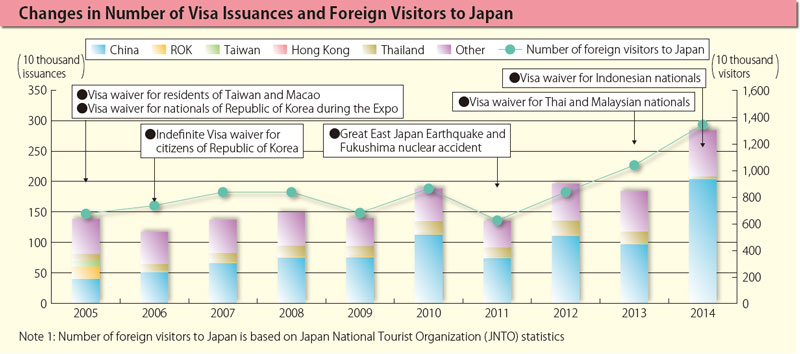Diplomatic Bluebook 2015
Chapter 4
Japan’s Diplomacy Open to the Public
1.Linking the Energy of Foreign Nationals to the Growth of Japan
(1) Growth Strategy and Relaxation of Visa Requirements
In the 2014 Revised Japan Revitalization Strategy released in June 2014, the Abe administration aims to increase the number of foreign visitors to Japan to 20 million by 2020, by taking advantage of the opportunity presented by the 2020 Tokyo Olympics and Paralympics Games, and the whole government is committed to making Japan a tourism-oriented country. Following the relaxation of visa requirements, including the waiver of visa requirements for visitors from Thailand and Malaysia in 2013, MOFA further relaxed visa requirements in 2014 for countries from which the number of visitors is expected to grow strongly, which is set out in the Japan Revitalization Strategy and the Action Program toward the Realization of Japan as a Tourism-Oriented Country. In specific terms, the following measures were taken: the introduction of multiple visas for nationals of Myanmar on January 15, the introduction of multiple visas for nationals of India on July 3, substantial relaxation of the requirements for the issuance of multiple visas for nationals of Indonesia, the Philippines, and Vietnam on September 30, simplification of the application procedure for single tourism visas for nationals of these three countries participating in package tours that are handled by accredited travel agencies on November 20, and visa waiver for Indonesian nationals based on a System of E-Passport Registration on December 1. Furthermore, when Prime Minister Shinzo Abe visited Brazil in August, he announced the introduction of multiple visas for Brazilian nationals, which was followed by the announcement by Foreign Minister Fumio Kishida of relaxation of the requirements for multiple visas for Chinese nationals, on the occasion of the APEC Ministerial Meeting (Beijing) on November 8. Currently, coordination is underway toward early implementation of these measures. These measures are expected to contribute to the efforts for the promotion of a tourism-oriented country and regional revitalization as well as to generating such effects as increasing the number of people who understand Japan and deepening international exchange.

The Japan National Tourism Organization (JNTO) released a statistics that indicated a dramatic increase in the number of visitors from the countries to which Japan extended relaxation of visa requirements, thanks to such factors as depreciated yen, expansion of LCC routes or proliferation of duty-free shops in Japan. The number of foreign visitors in 2014 exceeded 13.41 million, surpassing by far the record high of annual visitors registered in the previous year (10.36 million).
As described above, relaxation of visa requirements is expected to make some contributions to the promotion of people-to-people exchange and to the growth of Japan’s economy, thus prompting calls for further relaxation. At the same time, strict visa controls are practiced as a part of preventive measures in order to bar entry of undesirables, such as criminals and those who intend to work illegally, or those who could become victims of trafficking in persons. Aiming to achieve a balance between the promotion of a tourism-oriented country and Japan as the safest country of the world, MOFA is determined to continue working on the relaxation of visa requirements in the future, while minimizing the impact of the relaxation on public security by collaborating with relevant ministries, while paying attention to bilateral relations and diplomatic significance.
(2) Acceptance of Foreign Nationals / Social Integration
Since the Lehman Shock in 2008, the number of foreign long-term residents in Japan had been in downward trend; however, it turned to an increasing trend in 2012. With an aging and shrinking population, it is important for Japan to secure highly capable human resources, irrespective of their nationality, in order to further vitalize Japan’s economy and to improve its competitiveness. The 2014 Revised Japan Revitalization Strategy specifically targets further utilization of foreign human resources, and it is hoped the number of competent foreign nationals living in Japan will increase in the future.
MOFA has been cooperating with relevant ministries and agencies on a series of measures that would ensure respecting of human rights of foreign nationals. MOFA also hosts international workshops on the acceptance of foreign nationals and their integration into Japan, aiming to encourage debate among people by providing opportunities to discuss concrete issues and measures. At the workshop held in February (co-hosted by MOFA and the International Organization for Migration (IOM)) under the theme of “Advance together with Young Foreign Nationals – Challenge for Future Generations,” discussions were conducted focusing on educational problems, acceptance of diversity and challenges that the next-generation foreign nationals face in Japan, and the participants shared the recognition of various challenges in living together with young foreign nationals.

 Workshop
Workshop
During National Disaster-Prevention Week in September, MOFA organized “Briefing session on the Safety Confirmation Process of missing foreign nationals in Japan in case of disasters,” using the lessons learned from the Great East Japan Earthquake. With participation from the National Police Agency and the Ministry of Justice, in addition to the Tokyo Metropolitan Government and municipality-related organizations, such as the Tokyo Fire Department, the briefing session was held in an effort to cultivate mutual understanding of each organization’s roles and initiatives and to promote network building.
Ten years ago, the number of foreign visitors to Japan was 6 million on annual basis. In 2013, this number exceeded 10 million for the first time, and in 2014, reached 13.41 million all at once. In particular, a large number of people from Southeast Asia and China visited Japan. This could be attributed to the multiplier effect created by the relaxation of visa requirements and various initiatives to attract tourists. Although Chinese tourists had already been a common sight even before the relaxation of visa requirements, visa exemptions for Thailand and Malaysia that were introduced in 2013 led to a particularly significant rise in the number of tourists from these countries who visit sightseeing spots across Japan. Recently, in addition to the classic tourist destinations of Tokyo and Kyoto, ski resorts in Hokkaido and other parts of Japan are also welcoming tourists from the South who yearn to see and experience snow. It is a common sight that these tourists enjoy skiing as well as snowball fights and playing on sleds.
 Cycling event
Cycling event (Yamanashi City, April 4; Source: Yamanashi Prefecture)
In tandem with such moves to relax visa requirements for Southeast Asia and China, hotels in various regions are putting effort into attracting tourists through various Japanese culture activities. Some examples of these include not only tea ceremony and flower arrangement, but also dressing in yukata, hands-on experience in the making of sushi, Japanese drumming and being a ninja, as well as all-you-can-eat crab buffets. Furthermore, Yamanashi Prefecture is putting effort into sports initiatives. For example, a local Japan Professional Football League team has got an Indonesian soccer athlete, who is regarded as a national idol in his country, and Yamanashi Prefecture is organizing tours for visitors to watch the soccer matches. It is also organizing cycling events where cyclists can enjoy views of Mt. Fuji at the same time. In such ways, the national government, together with local governments, the hotel and restaurant industry, and the tourism industry, are joining hands through public and private sector cooperation to establish a tourism-oriented country. An increase in the number of foreign visitors to Japan not only contributes to the Japanese economy through domestic spending, but also helps to strengthen the sense of affinity and goodwill that foreign visitors will have of Japanese culture such as cuisine and history, and nature and products, as well as Japan and the Japanese people. This eventually contributes to promoting understanding of Japan, people-to-people exchanges and building friendly relations with other countries.
Visa exemption was first introduced for France in 1955. Today, it has been extended to 67 countries and regions, with the new additions of Thailand, Malaysia, and Indonesia. As a result of the efforts to promote Japan as a tourism-oriented country, the distance between Japan and China, as well as Southeast Asian countries, has diminished dramatically in recent years. The Government of Japan will continue “All-Japan” efforts, aiming to draw in 20 million foreign visitors by the year 2020.
Q.What are visa exemption/relaxation of visa requirements?
A.Generally, foreigners are required to have a visa to enter Japan. Currently, this visa requirement is exempted for 67 countries and regions that are considered to pose few problems in aspects such as security.
In addition, visa requirements are also being relaxed for China and countries of Southeast Asia, particularly for countries where many visitors to Japan are expected to come from. The relaxation of visa requirements involves relaxing some of the visa issuance criteria for visa application such as economic means, simplification of application documents, issuance of multiple entry visas that allow the visitor to enter the country multiple times during the validity period, or introduction of visa exemptions.

